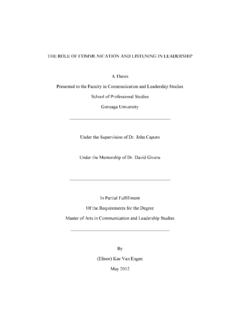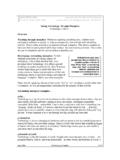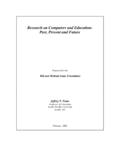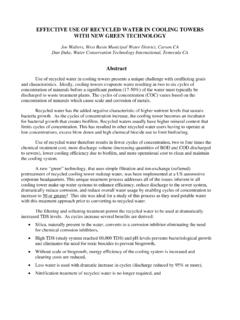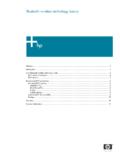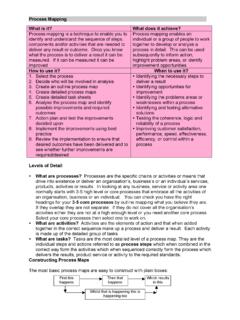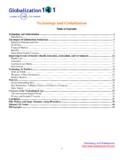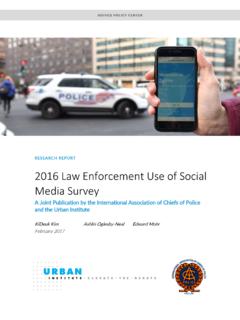Transcription of DOES THE USE OF TECHNOLOGY IN THE …
1 does THE USE OF TECHNOLOGY IN THE classroom increase students overall academic performance ? A Thesis Presented to the Faculty in Communication and Organizational Leadership Studies School of Professional Studies Gonzaga University Under the Supervision and Mentorship of Dr. Heather Crandall In Partial Fulfillment Of the Requirements for the Degree Master of Arts in Communication and Leadership Studies By J. Mariah Brown December 2011 TECHNOLOGY in the classroom 2 Abstract Technological advances and a decrease in the cost of TECHNOLOGY have resulted in nearly 93 percent of public schools classrooms in the United States having access to the Internet, and a considerable increase in educational programs that incorporate TECHNOLOGY into the curriculum (North Central Regional Educational Laboratory, 2005). Due to the prevalence of TECHNOLOGY in the classroom , the effectiveness of such programs has become a prevailing research topic amongst social scientists.
2 This thesis reviews past research and provides an analysis of relevant studies conducted within the last ten years. Using Daft and Lengel s media richness theory as a basis, this meta-analysis provides a comprehensive overview of the effect of TECHNOLOGY enhanced learning (TEL) programs on K-12 students overall academic performance and factors that can increase the effectiveness of such programs. TECHNOLOGY in the classroom 3 TECHNOLOGY in the classroom 4 Table of Contents CHAPTER I: The Importance of the Definition of Organization of Remaining CHAPTER II: REVIEW OF THE Philosophical Assumptions and Theoretical The The Prevalence of TECHNOLOGY in the TEL and Increased academic What Factors Make TEL Conducive to Increased Learning? ..17 Research CHAPTER III: SCOPE AND Scope of the Methodology of the CHAPTER IV: THE The Teacher and Administrator Learning with TEL TEL and Cultural CHAPTER V: SUMMARIES AND Limitations of the Recommendations for Further TECHNOLOGY in the classroom 5 CHAPTER I: INTRODUCTION The Problem TECHNOLOGY has increasingly become an integrated part of our lives so much so that it seems preposterous to even think of doing the most simple, routine tasks without the use of a cellular phone, laptop computer, or personal global positioning system, more commonly known as GPS.
3 While people of all ages increasingly use TECHNOLOGY for routine tasks, children are among the most frequent users of TECHNOLOGY (Kaiser Family Foundation, 2010). Just as TECHNOLOGY has changed aspects of our daily lives, it is undoubtedly changing education. Technological advances provide easier facilitation of and access to information, but TECHNOLOGY does not change the message received by students , or the students ability to grasp and retain information (Thurlow, Lengel, & Tomic, 2004, p. 42). TECHNOLOGY that is incorporated into the classroom for the purpose of enhancing the learning process is referred to as TECHNOLOGY enhanced learning (TEL) (Dror, 2008). Despite high expectations of the ability of school administrators and teachers to enhance student learning through the incorporation of TECHNOLOGY in the classroom , TEL programs have produced lackluster results (Sinclair, 2009, p.)
4 46). The history of TECHNOLOGY in the classroom is one of cycles of exaggerated promises, highly publicized installations with committed teachers, and masterful and inventive excuses for why the promises went unfulfilled (Venezky, 2004, p. 3). Problems implementing TEL programs have risen due to lack of understanding of the most effective approaches of selecting which technologies to use, the most effective ways to integrate TECHNOLOGY , and a lack of understanding of what factors may impact the effectiveness of TEL programs (Bordbar, 2010; Communication Without Barriers, 2007; Sinclair, 2009; Venezky, 2004). Additionally, during the TECHNOLOGY integration process, a common problem is that TECHNOLOGY in the classroom 6 teachers often rely on the TECHNOLOGY to teach students , rather than using the TECHNOLOGY as an educational tool, or the TECHNOLOGY is used in situations that do not warrant its use (Dror, 2008; Honan, 2010).
5 When implementing TECHNOLOGY into curriculum, it is critical to assess what tasks can be completed without the use of various technologies, and to remind ourselves of what may be lost when we do use them (Beniger, 1989, p. 120). Importance of the Study As TECHNOLOGY is increasingly incorporated into curriculum in K-12 classrooms around the globe, understanding the implications of using TEL to achieve educational objectives becomes increasingly important. The last two decades have witnessed a worldwide proliferation of information and communication technologies (ICT) into the field of education. The global adoption of ICT into education has often been premised on the potential of the new technological tools to revolutionize an outmoded educational system, better prepare students for the information saga, and accelerate national development efforts.
6 (Bordar, 2010, pp. 179-180) The cost of TECHNOLOGY and educational platforms has also become increasingly inexpensive, which has made TECHNOLOGY more universally accessible (Klein, 2010). The increased accessibility of TECHNOLOGY means that schools around the world, with students from various socio-economic backgrounds, are increasingly exposed to TEL. Therefore, understanding the impact of TEL programs, and the best ways to integrate TECHNOLOGY into the classroom , is critical. Previous research indicates that when used properly, TECHNOLOGY can enhance the learning experience and increase academic performance . Whether TECHNOLOGY in the classroom is beneficial is dependent upon the way in which the TECHNOLOGY is used by teachers implementing TECHNOLOGY in the classroom 7 the TECHNOLOGY , teacher competency levels with the given TECHNOLOGY , the degree to which the TECHNOLOGY is utilized in the classroom , and the type of TECHNOLOGY used (Sinclair, 2009).
7 A meta-analysis of more research on the topic can provide insight into the integration of TEL to ensure that learning is enhanced, and external factors that could impact TEL programs. Definition of Terms academic performance : communication and collaboration skills, student motivation, and independent learning. Contingency theory: Suggests that no particular way to make decisions for, or organize an organization, is best for all because every organization is unique (Daft & Lengel, 1986). Information and communication TECHNOLOGY (ICT): TECHNOLOGY used as a tool to enhance learning (Bordbar, 2010). Information processing theory: A cognitive development theory that humans process, rather than simply respond to stimuli, which effects memory and application of information (Fischer, 2010). K-12: students enrolled in school in Kindergarten through twelfth grades.
8 Media multitasking: Using more than one medium at once (Kaiser Family Foundation, 2010). Media richness theory (MRT): A theory that suggests certain technologies may be more desirable when they feature characteristics that aid in the usability of the TECHNOLOGY and dissemination of information (Daft & Lengel, 1986). Meta-Analysis: A research method that draws conclusions about the strength or consistency of communication effects across studies (Rubin, Rubin, Haridakis, & Piele, 2010). Multi-user virtual environment (MUVE) games: Gaming systems that enable multiple users to simultaneously participate in shared virtual environments (Mallan, Foth, Greenaway, & Young, 2010). TECHNOLOGY enhanced learning (TEL): Educational programs that incorporate various technologies with an objective of increasing learning (Dror, 2008).
9 Organization of Remaining Chapters In order to provide a comprehensive view of the effects of TECHNOLOGY in the classroom , past research and present analysis was organized into the four remaining chapters: 2) review of TECHNOLOGY in the classroom 8 previous literature; 3) research scope and methodology; 4) the study; and 5) summaries and conclusions. The first chapter of this study summarizes the importance of the research on TEL programs. Previous research on the effectiveness of TEL programs, philosophical assumptions, and theoretical framework on which the study is based are reviewed in the second chapter. Chapter three discusses the scope of the study and the methodology used. Analysis, including review of research trends and discussion of research findings, is provided in chapter four. Chapter five includes limitations of the study, recommendations for further research, and final conclusions and thoughts.
10 TECHNOLOGY in the classroom 9 CHAPTER II: REVIEW OF LITERATURE Introduction The fact that there has been a surge in the presence of TECHNOLOGY in classrooms throughout the United States and the world is common knowledge. However, the effectiveness of TEL programs has become a subject of debate. The level of effectiveness of TEL programs largely depends on the way in which the TECHNOLOGY is integrated into the curriculum and how it is viewed by students , teachers, and school administrators.. TECHNOLOGY is only a tool; it allows us to develop dialogue and interaction, but is a means, not an end in and of itself. Tech-based global education has the capacity to improve critical thinking and cultural pluralism but requires far more than just fancy TECHNOLOGY ; it requires careful, thoughtful curriculum development, and the support of organizations whose goal is to build authentic global communities online.

